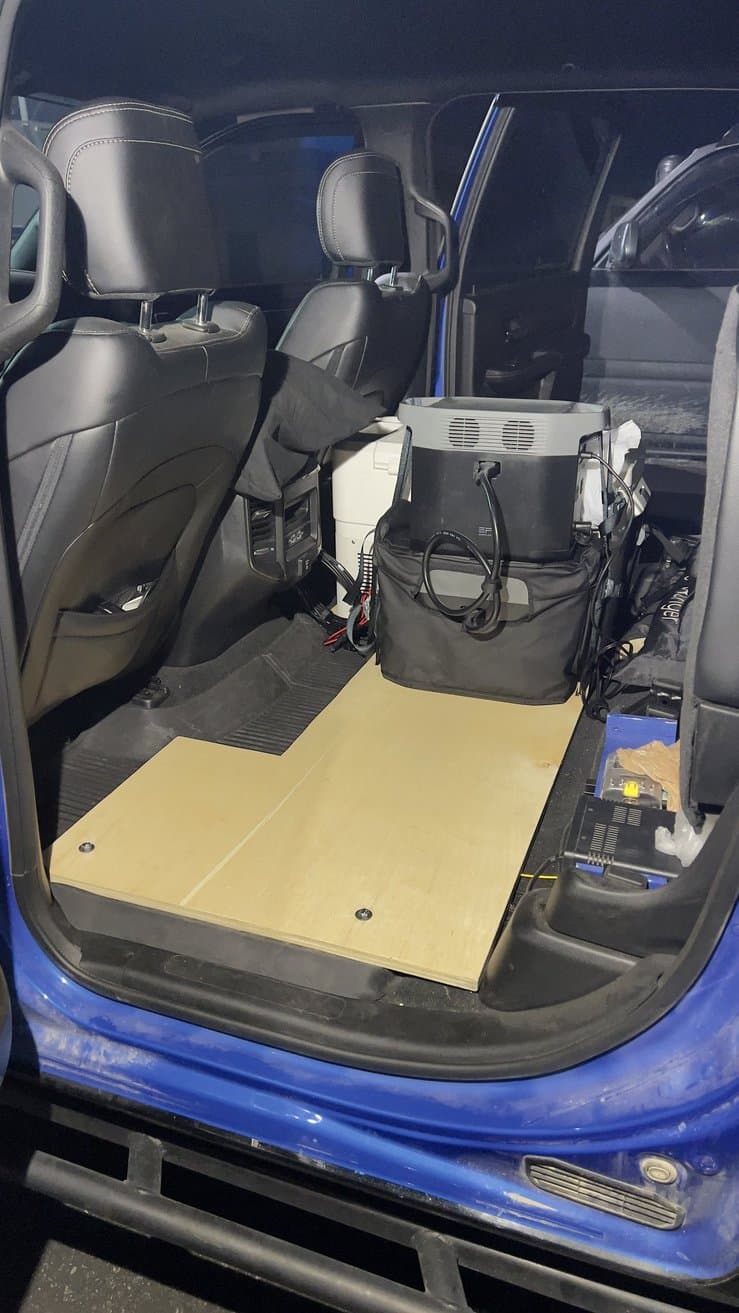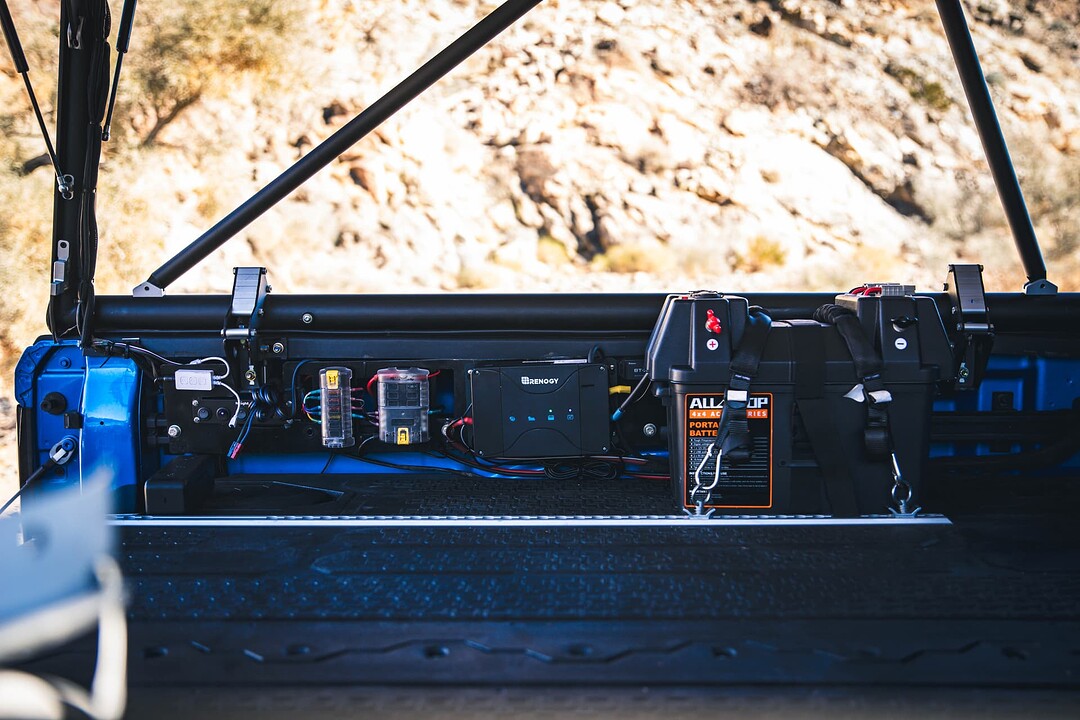so chiming in since I currently run both systems in my truck.
Systems:
I utilize an Ecoflow Delta 2 with Delta Max (first gen) add-on battery in the cab. That is the “solar generator”
I also utilize a LiFEPO4 in the bed. That is the “solar to battery” setup.
I also have 2 160w Ecoflow portable solar panels for in-cab and a 175w Renogy flex panel for roof mount should I do “base camp” mode (i have yet to mount the flex panel)
A bit of truck:
my truck is a Ram 1500 Rebel with e-torque, which utilizes a generator and 48 lithium battery instead of traditional alternator system to charge the battery. The benefit of this is the generator generates 48v of voltage and store it in the small lithium battery to help drive the driving wheels half a turn when starting from a stop and it also powers the start/stop function, as well as charging the starting battery.
Now, the starting battery is the power source/ relay of both systems. It also powers all of my exterior lights. The longevity of this system with my usage is yet to be tested and determined so we’ll see how it goes.
Usage
My primary usage for the in-cab setup is to power the fridge and have the ability to charge various USB gizmos and drones while on the go. In addition, the in-cab setup also powers Starlink while at camp.
My primary usage for the in-bed setup is to power the camp lights for hours, as well as to run the diesel heater during winter months. I am also planning to add an inverter to run my Ecoflow Wave (first gen) for summer months.
I am forgoing the “solar” part at this time because I don’t really do “base camp” mode. When I go camping/ overlanding, I am always on the move so I rely on engine supplied power.
In the cab
-Parts:
- Ecoflow Delta 2 + Delta Max Add-On Battery, giving me total of 3000wh of capacity.
- Victron 12/24 DC-DC charger. This allows me to charge my EcoFlow with XT60i at almost 400w peak. To charge my in-cab “generators” from 15% to 100% only takes ~3 hours when driving. The system disconnects itself after ignition has been turned off
- I run a dedicated 4 gauge power and ground through the firewall to power various other items using Blue Sea Fuse Block with Ground, including the Victron that in terms charges the EcoFlows. So far, only the mobile HAM radio and a quick disconnect for the fridge are plugged in. With this setup, should I choose to run fridge directly to the car battery while driving so I can use the 12v plug on the Ecoflow to charge my drone batteries.

(sorry for the bad quality pic… I just realized I never properly took picture of my in-cab setup. I’ll find a time to do it) The blue mount on the bottom right has the Blue Sea mounted next to the Ham Radio brain. The yellow cable that goes under the wood is the trigger wire for the Victron. Victron sits on the bottom of the blue mount. The wood platform is a floor mount that I’m R&Ding for in-cab floor mount for Ram 1500s.
-Benefits:
- I keep the fridge in the cab instead of in the camper contrary to many others because the bed is not 100% dust proof, and I like to keep my more sensitive electronics protected.
- I also charge my trail map tablet using EcoFlow, since the onboard USB chargers are not enough to charge the tablet while it’s running at 100% brightness.
- I can change the gizmo I’m charging on the fly. Most are just USB powered items so I don’t have to stop to swap.
- The Victron is fast charging, even it’s used to power the fridge while being charged.
- With the Ecoflow inside the cab, I can monitor it by listening to the beep when electricity is being fed to it to know when it’s being charged without pulling out the app or looking at the screen.
-Drawbacks:
None so far. I could use a faster DC-DC charger but it’s not really necessary.
In the Camper
-Parts:
- 6 gauge power and ground from battery with trigger wire
- LiTimes 100AH LiFEPO4
- Renogy 50A DC-DC charger with MPPT
- All-Top Battery Box
- Blue Sea Fuse Bar and Fuse Block with Ground
- Nilite switches
-Benefits:
- This stand alone system is dedicated to the camper only.
- The Renogy DC-DC with MPPT disconnects itself when the ignition is off, so I don’t have to worry about draining the starting battery. I can easily add solar charging to it with the Renogy flex panel should I have the need for it.
- The 100AH LiFEPo4 gives about ~1000wh of capacity, more than capable of running diesel heater for over 24 hours non-stop. It also is capable of powering my camper lights for hours on end while charging my phone and tablet.
- The battery box comes with a voltage display, USB ports, 12v sockets, and 2 50A Anderson connectors. I elect to wire a fuse block with ground to it to have switched power to everything though.
- The Blue Sea Fuse Bar, Nilite switch, and Fuse Block with Ground only serve one purpose - to be able to turn on and off things. Power is sent to the Fuse Block, which powers the switches. Switches then goes to Fuse Bar, which goes to all the components. When the switch is off, lights are off. When the switches are on, lights are on. Fuse bar serves as a safety so I don’t start a fire should any of the lights short out. The fuse block also serves as a grounding point for all components before grounding back to the battery.
-Benefit:
- Dedicated system for the bed
- Ability to add another switch
- Fast charging and big capacity - Renogy pushes out 50A max but I’ve yet to see it happen. I’ve yet to drain the LiFEPo4 either.
- Rooms for upgrade and swap out systems.
-Drawbacks:
- No monitoring system (I could add it but that’s another $80 or so)
- Nilite switch is some cheap chinese product. Reliability, especially when exposed to water and dust, is questionable.
- Lots of wiring.
(Left to right: control box for lower floor camper lights, Nilite switches, Blue Sea Fuse Bar, Blue Sea Fuse Block with Ground, Renogy DC-DC charger with MPPT, All-Top Battery Box with LiFEPO4 inside)
What do I think of each system?
If you want a one-size-fit-it-all solution, solar generators will be your best choice. It is everything you need and more, but it is expensive if you get a quality product and not just some unknown cheap Chinese brand. A 1000w unit is plenty if all you want to run your fridge overnight. If you’re always on the go, a Victron 12/24 DC-DC charger is going to be your best bet. You won’t even need solar with it. With Ecoflow, you do get the ability to expand your capacity. If you also want to run AC powered items like a Starlink or even an A/C in summer, the solar generators will satisfy those demands. The only drawback is the price tag.
If you want something more customized or you want to source your own parts and have the ability to upgrade components in the future, then solar to battery will be your choice. Depends on the components used, it CAN be cheaper to set up. This also eliminates many output restrains found on solar generators. For instance, many solar generators can’t start a diesel heater because the starting process takes way too much amperage for the 12v sockets in those generators, but with a direct-to-battery setup using correct fuse it is of no problem to solar-to-battery setup (aka, my camper setup). However, purchasing the correct hardwares (Blue Sea components, especially) can get expensive.
Honestly though, I wouldn’t recommend solar as the primary or the only power input. It is far too weather dependent. When it’s overcast, you won’t get enough juice to replenish what you’ve used overnight. Whichever route you choose (solar generator/ solar to battery), I strongly recommend running a DC-DC charger as your primary.
*Note: both systems have their individual Blue Sea 100A circuit breaker near the power source. ALWAYS run a quality (aka, Blue Sea) breaker to avoid over consumption or starting a fire. *

